
Media Art Content and Achievement Standards for the state of North Dakota. Updated 2019.
- Subject:
- Arts and Humanities
- Material Type:
- Primary Source
- Author:
- Brandon Lemer
- Date Added:
- 12/11/2019

Media Art Content and Achievement Standards for the state of North Dakota. Updated 2019.

Dance Content and Achievement Standards for the state of North Dakota. Updated 2019.

Music Content and Achievement Standards for the state of North Dakota. Updated 2019.

Music Content and Achievement Standards for the state of North Dakota. Updated 2019.

Visual Arts Content and Achievement Standards for the state of North Dakota. Updated 2019.

Theatre Arts Content and Achievement Standards for the state of North Dakota. Updated 2019.

This resource is a video abstract of a research paper created by Research Square on behalf of its authors. It provides a synopsis that's easy to understand, and can be used to introduce the topics it covers to students, researchers, and the general public. The video's transcript is also provided in full, with a portion provided below for preview:
"The Materials Research Society is proud to announce the 2020 MRS Communications Lecture honorees, Drs. Chun-Teh Chen and Grace Gu from the University of California, Berkeley. The honor recognizes excellence in the field of materials research through work published in MRS Communications. Drs. Chen and Gu are recognized this year for their prospective paper on how researchers are harnessing artificial intelligence to accelerate the design and discovery of composite materials. Their work is featured in volume nine, issue two of MRS Communications. Composites are combinations of two or more base materials, whose collective properties exceed those possessed by either material alone. Composites are widely used as structural materials in the automotive and aerospace industries and can also be easily found in nature. Limitations in manufacturing methods have generally restricted the architecture these materials take on in real-world applications. Most commonly, they’re processed into multilayer sheets..."
The rest of the transcript, along with a link to the research itself, is available on the resource itself.
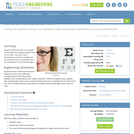
In this activity, students determine their own eyesight and calculate what a good average eyesight value for the class would be. Students learn about technologies to enhance eyesight and how engineers play an important role in the development of these technologies.
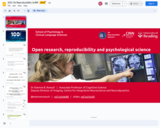
General slide deck on reproducibility.
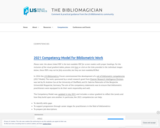
In 2016 the LIS-Bibliometrics Forum commissioned the development of a set of bibliometric competencies (2017 Model), available at https://thebibliomagician.wordpress.com/2017-competencies-archived/. The work, sponsored by a small research grant from Elsevier Research Intelligence Division, was led by Dr. Andrew Cox at the University of Sheffield, and Dr. Sabrina Petersohn of the Bergische Universität Wuppertal, Germany. The aim of the competency statements was to ensure that bibliometric practitioners were equipped to do their work responsibly and well.
The Competency Model was updated in July 2021 and includes a colour gradient to reflect the Levels and how they build upon one another. In particular, the 2021 competencies can help:
To identify skills gaps
To support progression through career stages for practitioners in the field of bibliometrics
To prepare job descriptions
The work underpinning the paper is available here: http://journals.sagepub.com/doi/abs/10.1177/0961000617728111. It is intended that the competencies are a living document and will be reviewed over time.
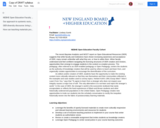
Learning objectives:
-Leverage the benefits of openly licensed materials to create more culturally responsive and relevant learning environments and resources for students
-Develop a set of inclusive teaching practices to implement in your course that center students as authoritative voices
-Revise or create a renewable assignment that invites students as knowledge creators
-Leverage Open Pedagogy to center social justice in your course learning outcomes
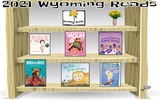
The Sue Jorgensen Library Foundation was created in 1996 to benefit libraries and advance the cause of childhood literacy in Wyoming. The program has grown to include celebrations in all of Wyoming’s 23 counties, distributing a book to every first grader in Wyoming. Each year since 2006, the Governor has issued a proclamation declaring Wyoming Literacy Day to fall in conjunction with this valuable statewide celebration. The student choice boards will connect students to each book selected for Wyoming Reads 2021 and provide activities to go along with the theme of each book. Make a Copy 2021 Student Choice Boards

SR Caucus Business/Networking Meeting Minutes June 2022

MLA SR Caucus-Mid Year Meeting Minutes October 2022

June 24–July 1, 2022
Word Count: 1825
(Note: This resource's metadata has been created automatically as part of a bulk import process by reformatting and/or combining the information that the author initially provided. As a result, there may be errors in formatting.)

SR Caucus 2023 April Business Meeting Minutes

Short Description:
The aim of this compendium is to provide nurse educators with an easily accessible collection of 25 resources designed to support student learning, particularly within nursing programs.
Long Description:
The aim of this compendium is to provide nurse educators with an easily accessible collection of OER designed to support student learning, particularly within nursing programs.
A search of the Pressbooks directory was undertaken to identify resources for potential inclusion in this compendium. These resources were filtered according to the following inclusion criteria: nursing authorship; North American; published after 2015; and intended for nursing students. Materials were excluded if they were identified as self-published books or were not openly licensed.
This resulted in a total of 25 resources that address areas inclusive of, but not limited to, health assessment, nursing leadership and management, foundational nursing practice skills, and the care of special populations.
The compendium is presented as a tabulation of key elements for each of the 25 resources, adapted from the Faculty Guide for Evaluating Open Education Resources. Five key elements are described relative to the criteria of credibility (i.e., authorship, publisher, year of most recent update), relevance (i.e., title of the open textbook, aim, intended audience, topical foci), accessibility/interactivity (i.e., figure and tables, videos, review questions, total interactive H5P activities), and licensing (i.e., availability for use with attribution).
Users of this compendium are encouraged to consider each of the tabulated elements (e.g. credibility, relevance, accessibility/interactivity, and licensing) to determine the merit of directly accessing a resource for potential inclusion as a supplement in a nursing course.
Word Count: 4284
(Note: This resource's metadata has been created automatically by reformatting and/or combining the information that the author initially provided as part of a bulk import process.)

June 14 2023 SR Caucus Meeting Minutes
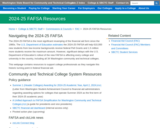
The 2024-25 FAFSA is the most significant revamping of the financial aid form since the 1980s. The U.S. Department of Education estimates the 2024-25 FAFSA will help 610,000 new students from low-income backgrounds receive federal Pell Grants and 1.5 million more students receive the maximum amount. However, significant delays with the U.S. Department of Education's rollout of the new FAFSA is affecting every college and university in the country, including all 34 Washington community and technical colleges.
This webpage contains resources to support college professionals as they navigate this historic turning point in federal financial aid.
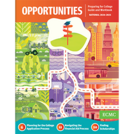
This free college-planning publication provides students and families with important information and tools to guide their pursuit of postsecondary education. Opportunities guides are available in English and Spanish. The state-specific booklets are the same as the national booklets with the addition of state-specific information on colleges, financial aid and resources.
This is an annual resource and is updated and printed each year.
For more information about this and related resources, visit https://www.ecmc.org/studentseducators/student-resources/opportunities-guide-and-workbook